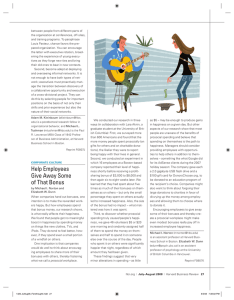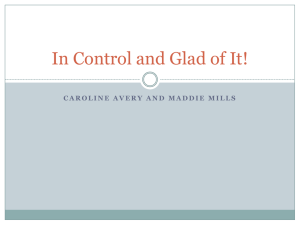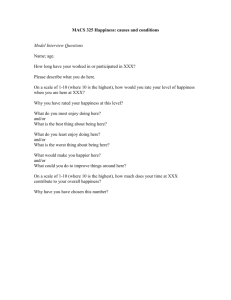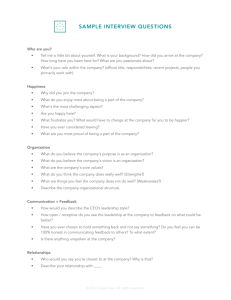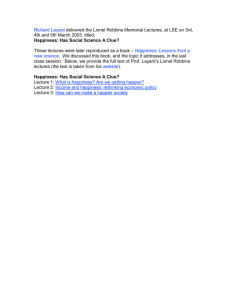Feeling Good about Giving: The Benefits (and Costs) of Self-Interested Charitable Behavior
advertisement
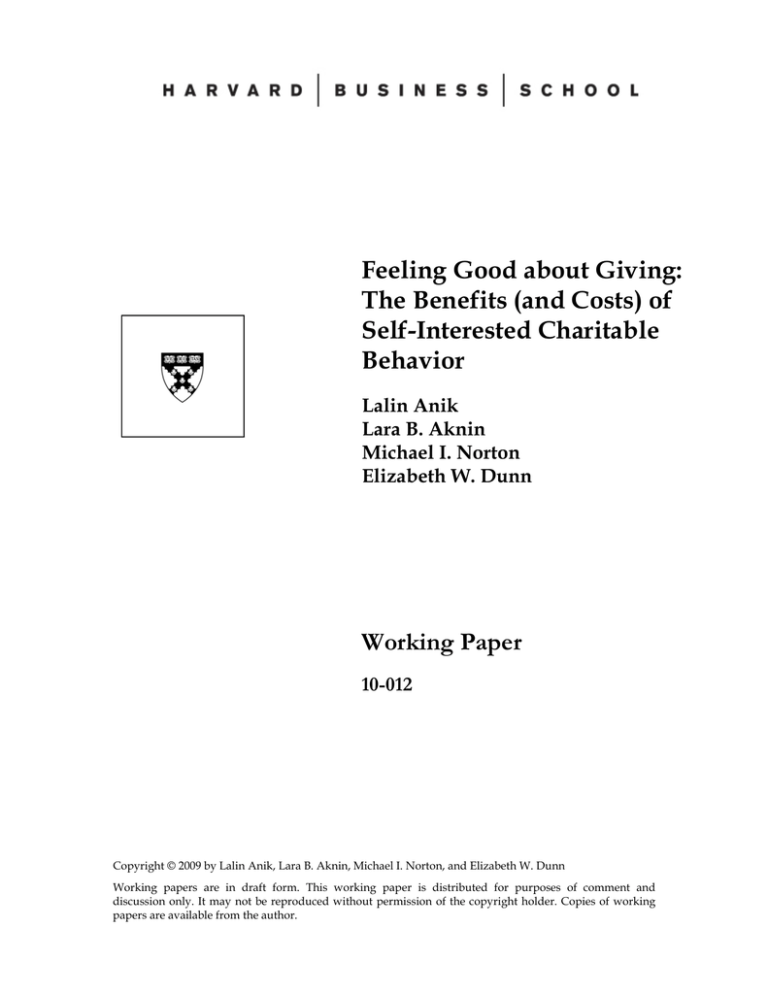
Feeling Good about Giving: The Benefits (and Costs) of Self-Interested Charitable Behavior Lalin Anik Lara B. Aknin Michael I. Norton Elizabeth W. Dunn Working Paper 10-012 Copyright © 2009 by Lalin Anik, Lara B. Aknin, Michael I. Norton, and Elizabeth W. Dunn Working papers are in draft form. This working paper is distributed for purposes of comment and discussion only. It may not be reproduced without permission of the copyright holder. Copies of working papers are available from the author. Feeling Good about Giving 1 Feeling Good about Giving: The Benefits (and Costs) of Self-Interested Charitable Behavior Lalin Anik, Harvard Business School Lara B. Aknin, University of British Columbia Michael I. Norton, Harvard Business School Elizabeth W. Dunn, University of British Columbia Feeling Good about Giving 2 Abstract While lay intuitions and pop psychology suggest that helping others leads to higher levels of happiness, the existing evidence only weakly supports this causal claim: Research in psychology, economics, and neuroscience exploring the benefits of charitable giving has been largely correlational, leaving open the question of whether giving causes greater happiness. In this chapter, we have two primary aims. First, we review the evidence linking charitable behavior and happiness. We present research from a variety of samples (adults, children and primates) and methods (correlational and experimental) demonstrating that happier people give more, that giving indeed causes increased happiness, and that these two relationships may operate in a circular fashion. Second, we consider whether advertising these benefits of charitable giving – asking people to give in order to be happy – may have the perverse consequence of decreasing charitable giving, crowding out intrinsic motivations to give by corrupting a purely social act with economic considerations. Feeling Good about Giving 3 People see a world out of whack. They see the greatest health crisis of 600 years and they want to do the right thing, but they’re not sure what that is. (RED) is about doing what you enjoy and doing good at the same time. —Bono, “Ethical Shopping: The Red Revolution,” Belfast Telegraph, January 27, 2006. Helping others takes countless forms, from giving money to charity to helping a stranger dig his car out of the snow, and springs from countless motivations, from deep-rooted empathy to a more calculated desire for public recognition. Indeed, social scientists have identified a host of ways in which charitable behavior can lead to benefits for the giver, whether economically via tax breaks (Clotfelter, 1985, 1997; Reece & Zieschang 1985), socially via signaling one’s wealth or status (Becker 1974; Glazer & Konrad 1996; Griskevicius et al., 2007) or psychologically via experiencing well-being from helping (Andreoni, 1989, 1990; Dunn, Aknin, & Norton, 2008). Charitable organizations have traditionally capitalized on all of these motivations for giving, from attempting to engage consumers with emotion-laden advertising to pushing governments to offer tax incentives. The psychological benefits of giving are underscored by Bono’s quote above, referring to the Product (RED) campaign, in which a portion of profits from consumer purchases of luxury goods is donated to the Global Fund for AIDS relief: Giving feels good, so why not advertise the benefits of “self-interested giving,” allowing people to experience that good feeling while increasing contributions to charity at the same time? In this chapter, we have two primary aims. First, we explore whether claims about the benefits of helping are in fact justified: While many appeals for charity center on the notion that helping makes the giver happy, a relatively small amount of research exists to support this causal claim. We review evidence that happy people give more, that giving is associated with and Feeling Good about Giving 4 causes happiness, and that these relationships may run in a circular fashion, such that happy people give more, then feel happier, then give more, and so on. Second, however, we consider the possible negative implications of advertising these well-being benefits in an effort to increase charitable behavior: When people start to give for “selfish” reasons – in order to feel good – instead of altruistic reasons – to help others – such extrinsic motivations may crowd out intrinsic motivation to help; as a result, helping behavior might increase in the short term as people seek benefits, but decrease in the long-term as people’s inherent interest in the welfare of others declines. Happier People Give More One of the first experimental studies to demonstrate that happiness increases charitable behavior was conducted by Isen and Levin (1972), who showed that after experiencing positive events (such as receiving cookies, or finding a dime left in a payphone), participants were more likely to help others: Thus, people who felt good were more likely to provide help. Replicating this effect in a different context, Aderman (1972) induced either an elated or depressed state by having participants read statements designed to induce these moods. Participants in a positive mood were more likely to help with a favor to the researcher during the experiment, and even promised to help by participating in a second experiment. Other positive mood states have also been shown to increase altruism; feelings of competence, for example, have been shown to increase helping and volunteering behavior (Harris & Huang 1973; Kazdin & Bryan 1971), as has succeeding on tasks (Isen, 1970). Young children exhibit similar effects of mood on helping. Rosenhan, Underwood, and Moore (1974) randomly assigned second and third graders to positive or negative mood conditions by having them reminisce about mood appropriate memories. To strengthen the mood Feeling Good about Giving 5 induction, children were asked to talk about these memories and then think about them once again. Children were then allowed to have some candy from a treasure chest (self gratification) and also give money to other students if they wished (altruistic behavior). While both happy and sad children ate more candy than those in the control condition, only happy children gave more money away to classmates. These results also suggest that prosocial behavior may not necessitate self-sacrifice, as happy children engaged both in more self-gratification and more altruistic behavior – like those consumers who buy Product (RED) iPods and enjoy the product while also giving to charity. Similar to results for adults, other positive mood states – such as the feeling of success – are related to prosocial behavior in children (Isen, Horn, & Rosenhan, 1973). While the majority of research has explored the impact of happiness on prosocial behavior via mood inductions, recent extensions have examined how naturally occurring moods influence helping behavior. Wang and Graddy (2008) suggest that happy people are both more emotionally capable to help others and have more optimistic personalities, fostering charitable giving behavior. Using individuals’ self-rated happiness as an indicator of psychological inclination to donate, they found that a feeling of happiness affected religious giving, but not secular giving, which may have stemmed from the association of happiness and religious giving in people’s minds. Konow and Earley (2008) also argued that happier people give more because they are fueled by their positive emotions. In the context of a dictator game, where a proposer divided a fixed endowment between himself and one other (the recipient), individuals who were happier at the beginning of the game were more likely to give at least a dollar to their partner. Positive moods, whether experimentally induced or naturally occurring, have also been shown to facilitate helpful behavior in the workplace. Forgas, Dunn, and Granland (2008) induced a positive, neutral, or negative mood in sales staff at a department store by engineering Feeling Good about Giving 6 an interaction with a confederate (posing as a customer) that varied in pleasantness. Next, another confederate approached the sales staff and requested help finding an item that did not in fact exist. While experienced staff members were largely impervious to the effects of mood, inexperienced staff provided more help—by trying to find the item, suggesting alternatives, and devoting more time to helping the customer—than did those in a neutral mood. Converging evidence for the benefits of positive mood on prosocial behavior in the workplace comes from research on naturally occurring mood; in a study by Williams and Shiaw (1999), employees who reported being in a good mood were more likely to display organizational citizenship behaviors that were not part of their formal job requirements. Taken together, the existing evidence suggests that happier people do indeed help more in a variety of contexts. Studies using random assignment to experimentally induce positive mood have provided important evidence that happiness causes increased helping behavior. Supporting the external validity of these findings, naturally occurring positive moods have also been shown to facilitate prosocial behavior. While we have focused on the impact of positive mood on giving, however, another well-documented area of inquiry has documented the impact of negative mood on helping as well, a seeming contradiction (see Batson, 1987; 1991). For example, Cialdini et al. (1987) showed that watching another person suffer a mild electric shock motivates helping in an observer through a sense of heightened empathy and increased personal sadness. Similarly, Small and Verrochi (in press) found that people were more sympathetic and likely to donate when charitable appeals contain victims with sad expressions, and the sadness experienced on the part of the donor mediates the effect of emotion expression on sympathy. We suggest that a key difference in the way these two research streams have operationalized mood may account for these seemingly disparate findings. Research exploring the impact of positive Feeling Good about Giving 7 moods on helping has generally focused on happiness – whether incidental as with finding money, or global as with overall well-being – unrelated to the specific cause or individual in need of charity, as opposed to negative mood directly tied to the victim: “I feel good in general, and so am going to give” rather than “I feel badly for that person, and so am going to give.” Future research should manipulate both factors independently to examine the interplay of positive and negative mood on giving. The research reviewed thus far has examined how moods – both positive and negative – cause people to give, as well as exploring the consequences of this behavior for the victim (i.e. whether they received help or not). This work, however, only addresses one direction of the causal arrow between mood and prosocial behavior. Below we review the evidence in the opposite direction. That is, does giving make people happy? Giving Makes People Happier Dialogue on whether prosocial behavior increases well-being dates as far back as ancient Greece, where Aristotle argued that the goal of life was to achieve “eudaemonia,” which is closely tied to modern conceptions of happiness. According to Aristotle, eudaemonia is more than just a pleasurable hedonic experience; eudaemonia is a state in which an individual experiences happiness from the successful performance of their moral duties. In recent years, popular opinion, self-help gurus and community organizations have endorsed the notion that helping others has mood benefits. Although these claims sometimes outpace the evidence base, a growing body of research provides methodologically diverse support for the hedonic benefits of generosity. Feeling Good about Giving 8 At the most basic level, functional magnetic resonance imaging (fMRI) evidence shows that giving money to charity leads to similar brain activity in regions implicated in the experience of pleasure and reward. In a study conducted by Harbaugh, Mayr, and Burghart (2007) neural activity was recorded while participants decided how to split a one-hundred dollar sum between themselves and a local food bank. Results showed that donations of the original one-hundred dollar sum to the food bank led to activation in the ventral striatum, a brain region associated with representing the value of a range of rewarding stimuli, from cocaine to art to attractive faces (Aharon et al., 2001; Vartanian & Goel, 2004; see Elliott, Friston, & Dolan, 2000). Thus, these results suggest that giving (in the form of charitable donations) is inherently rewarding. At a very different level of analysis – from brain to nation – Meier and Stutzer (2008) demonstrated that volunteering increases life satisfaction, through use of the German Socioeconomic Panel, a longitudinal study of German households. Consistent with other correlational studies of volunteering and well-being, they found that higher levels of volunteer work were associated with higher levels of overall life satisfaction. This study, however, is unique in that it examines the relationship between happiness and volunteer work around the collapse of the German Democratic Republic, providing a quasi-experimental design. Specifically, by looking at data collected shortly after the fall of the Berlin wall but prior to the German reunification, a time when volunteering opportunities dropped dramatically in Eastern Germany, happiness of East Germans can be compared to a control group who experienced no change in their volunteer status. Using this design, the authors are able to conclude that helping others increases well-being. While this study lacks true random assignment, it does offer Feeling Good about Giving 9 intriguing evidence of the impact of volunteer work on well-being in a large, nationally representative dataset. Additionally, some experimental work hints at a causal relationship between giving and happiness. For example, when Field, Hernandez-Reif, Quintino, Schanberg, and Kuhn (1998) asked a volunteer group of retired senior citizens to give infants a massage three times a week for three weeks, these seniors experienced less anxiety and depression, as well as improved health and a reduction in stress-related hormones. Further support for a causal link comes from recent work by Lyubomirsky, Tkach, and Sheldon (2004), which shows that simply asking people to commit random acts of kindness can significantly increase happiness levels for several weeks. Specifically, in their investigation, Lyubomirsky and colleagues randomly assigned students to a no-treatment control group or to an experimental group, in which students were asked to commit five random acts of kindness a week for six weeks. As predicted, students who engaged in random acts of kindness were significantly happier than controls. Finally, our own recent research suggests that altruistic financial behavior, such as gift giving and charitable donations, may promote happiness (Dunn, Aknin, & Norton, 2008). In an initial study, we asked a nationally representative sample of Americans to rate their general happiness and provide monthly estimates of personal and prosocial spending. Specifically, participants were asked to report their annual household income and general happiness level and to estimate how much they spent in a typical month on (1) bills/expenses, (2) gifts for themselves, (3) gifts for others, and (4) donations to charity. We summed categories 1 and 2 for an index of personal spending and categories 3 and 4 for an index of prosocial spending. Lastly, participants reported their general happiness on a one item happiness scale (Abdel-Khalek, 2006) which simply asked participants "Do you feel happy, in general?” Analyses revealed that Feeling Good about Giving 10 individuals who devoted more money to prosocial spending reported greater happiness, whereas personal spending was unrelated to happiness. Even controlling for income, higher prosocial spending was associated with greater happiness; income had an independent and similar association with happiness. While these results provide a first glimpse of the association between prosocial spending and happiness in the population, the correlational nature of this study restrains discussion of causal claims. Therefore, we also used an experimental design to test the casual claim that spending money on others leads to higher happiness levels than spending money on oneself (Dunn et al., 2008). Our hypothesis was that participants randomly assigned to spend money in a prosocial fashion would be happier at the end of the day than others assigned to spend money on themselves. Participants were approached in person during the morning hours (approximately 10am – noon) in public places and asked to reported their baseline happiness level. After doing so, participants were randomly assigned to one of four spending conditions, receiving either five or twenty dollars to spend on themselves or others. Specifically, participants in the personal spending condition were asked to use their windfall on a bill, expense or gift for themselves, while participants in the prosocial spending condition were asked to spend the money on a gift for someone else or donation to charity. All participants were asked to spend the money in line with their assigned spending direction by 5pm that day. Participants were then contacted in the evening hours (between 6pm-8pm) on the phone by a research assistant to complete a follow-up survey which assessed their current happiness level. As predicted, participants asked to spend their windfall in a prosocial fashion were happier at the end of the day than were participants in the personal spending condition. Interestingly, the amount of money people were given did not influence how happy they were that evening, suggesting that how people spent their money was Feeling Good about Giving 11 more important than how much money they received. Therefore, this experimental study provides support for the causal claim that spending money on others leads to higher happiness than spending money on oneself. Moreover, these results suggest that the spending amount need not be large to facilitate positive hedonic gains, as prosocial purchases made with as little as five dollars were sufficient to boost happiness levels. Does Happiness Run in a Circular Motion? The streams of research reviewed above – that happy people give more, and that giving makes people happy – beg an obvious question: Is there a positive feedback loop between happiness and giving? Previous research on volunteering and prosocial behavior has suggested that happier people are more likely to engage in these activities and subsequently experience higher happiness levels from doing so (e.g., Thoits & Hewitt, 2001; Piliavin, 2003). Thus, we explored whether the link between happiness and prosocial spending runs in a circular motion, such that recollections of previous prosocial spending makes people happier, and in turn, more likely to engage in prosocial spending in the future. To investigate this question, we asked a sample of students to think back and describe the last time they spent either twenty or one hundred dollars on either themselves or someone else. After describing this experience, each participant was asked to report their happiness. Next, each participant was given the opportunity to select the future spending behavior they thought would make them happiest from the four conditions presented in the experimental study described above (five or twenty dollars to spend on themselves or others). Our hypothesis was that recalling a prosocial spending experience would make people happier than recalling a personal spending experience – regardless of how much money was Feeling Good about Giving 12 spent – and that this boost in happiness would lead participants to select a prosocial spending choice in the future. To investigate whether recalling specific spending experiences influenced happiness levels, we compared the happiness ratings of participants in the four recall conditions. As expected, participants randomly assigned to recall a purchase made for someone else were significantly happier than participants assigned to recall a purchase made for themselves. We also predicted that this boost in happiness would shape people’s future spending choice, such that happier participants would be more likely to spend prosocially in the future. To investigate whether this happiness boost led participants to select a prosocial spending choice in the future, we used the purchase amount (twenty or one-hundred dollars), purchase target (oneself or others), and happiness to predict future spending choices. In line with our hypothesis, happiness was the only significant predictor of future spending choice, suggesting that participants made happier by recalling a previous purchase for someone else were significantly more likely to choose to engage in prosocial spending in the future. Further, mediational analyses confirm that other-oriented spending memories only fostered future prosocial spending choices to the extent that these recollections increase happiness levels in the interim. These data confirmed our hypothesis that prosocial spending and happiness fuel each other in a circular fashion. By asking participants to recall a previous time they spent money on others, we were able to observe that the prosocial spending recollections led to an increase in happiness. Furthermore, by allowing participants to make a future spending decision, we were able to show that this increase in happiness shaped spending decisions, such that happier people were more likely to make to make prosocial spending choices in the future. In addition, we have recently shown that these effects hold cross-culturally, with both North American and African Feeling Good about Giving 13 samples, offering preliminary evidence that the reciprocal links between giving and happiness may be a human universal. Will Increasing Awareness of the Benefits of Giving Lead to More, or Less, Giving? One implication of the research reviewed above is quite clear: If giving makes people happy, and happy people give more, then one means of increasing charitable donations is simply to inform people of this loop, making a rational appeal that self-interested giving can lead to higher well-being. Indeed, Dunn et al. (2008) showed that people erroneously believe that spending money on themselves makes them happier than spending money on others, suggesting that there is ample room for people to be “educated” to the contrary. Recently, many organizations appear to be engaged in efforts to link charitable donations with feel-good campaigns, as opposed to the classic campaigns involving images of in-need individuals designed to elicit sadness and guilt, as the quote with which we opened from Bono suggests “(RED) is about doing what you enjoy and doing good at the same time.” And (RED) is far from alone in this messaging, as slogans from many of the largest charitable organizations reflect these feel-good impulses: the American Red Cross’s tells prospective blood donors that “the need is constant. The gratification is instant,” CARE asks donors to “Help us empower women around the world” with the slogan “I am powerful” applying to both donors and recipients, and Susan G. Komen for the Cure asks each donor, “Are you inspired to save a life?” Enjoyment, instant gratification, empowerment, inspiration – all of these sentiments offer powerful emotional incentives for people to donate. At the same time, however, any social scientist knows the possible costs of tampering with behaviors that arise from intrinsic motivations, as ironic effects often stem from Feeling Good about Giving 14 incentivizing such behaviors. In an early demonstration, Lepper, Greene, and Nisbett (1973) showed that rewarding children for their performance – “overjustifying” their interest – undermined those children’s intrinsic motivation to do well. Relatedly, Titmuss (1970) argued that paying for blood donation would undermine the social utility of the act. More generally, “crowding out” intrinsic motivation through external incentives (see Frey & Jegen, 2001) carries the risk that incentivizing behaviors that are socially motivated may move those behaviors from the social realm into the economic realm, with sometimes unexpected – and detrimental – results. Indeed, presenting people whose charitable behavior is motivated by altruistic impulses with self-interested appeals can be alienating (Nelson, Brunel, Supphellen, & Manchanda, 2006). What happens when social behaviors – like helping others – move into the economic realm? In one compelling demonstration, Gneezy and Rustichini (2000a) documented the ironic outcome that emerged when the owners of a childcare center instituted fines for parents who were late to pick up their children. Lateness actually increased when fines were instituted; while most parents had made a good faith effort to arrive on time when not doing so was rude to the owners of the center, the institution of fines made showing up late an economic matter, with parents simply calculating the costs and benefits of tardiness. Most troubling, when the owners discontinued the fines, parents did not revert to their earlier behavior, suggesting that when social markets are made economic, it may be difficult to change them back. The impact of switching from social to economic markets helps to explain some curious results in which people work harder for no money than for low pay (Gneezy & Rustichini, 2000b). People are willing to engage in effort such as helping others or doing favors for them for social reasons; once money is introduced, however, people engage in cost-benefit analysis, and small amounts of money are not sufficient to incentivize them to do the work they were willing to do for free for more Feeling Good about Giving 15 altruistic reasons; moreover, mixed markets – where both social and economic incentives are present – look like economic markets, as though the mere whiff of monetary incentives corrupts social motivations (Heyman & Ariely, 2004). How might these dynamics play out specifically in the domain of charitable giving? While researchers have only recently devoted attention to this issue, early results suggest that mixing economic incentives with social incentives may have similar effects as in other domains. At a general level, the mere thought of money undermines people’s motivation to engage in prosocial behavior (Vohs, Mead, & Goode, 2006), and several investigations have demonstrated the negative impact of mixing incentives with charitable giving. For example, Falk (2007) examined the impact of sending gifts to possible donors on their frequency and amount of donation. Small gifts increased donations by 17% and large gifts by 75%, but people who received large gifts were more likely to donate smaller amounts, while those who received no gift were most likely to donate large amounts; while only suggestive, these results imply that receiving gifts may crowd out some inherent motivation to give. Two investigations that explored the impact of matching donations – in which an employer or other agency matches the amount of one’s donation to some charity – showed that matching did increase people’s likelihood of contributing (Karlan & List, 2007; Meier, 2007). Importantly, however, Meier (2007) showed that while initial contribution rates increased, contribution rates actually declined after the matching offer ended, leading to a net loss in giving. Again, these results suggest that providing people with external incentives to give – a matching donation, or a gift – may undermine some of their intrinsic interest in giving in the longer term. But does advertising the mood benefits of charitable acts alter the reasons and outcomes of donating? Specifically, we wondered whether the effects we demonstrated in Dunn et al. Feeling Good about Giving 16 (2008) might be undermined by adding external incentives to people’s reason for giving. In short, we asked two related questions: If people are aware that giving to others makes them happier, will they a) give more money and b) will this incentive undermine the happiness they receive from giving to others? In an initial test of this question, we asked a sample of over 1,000 readers of the New York Times, who had just read about our research demonstrating the link between giving and happiness, to answer questions about their personal and prosocial spending and their well-being. Compared to our other studies, respondents reported spending a relatively large amount on others (some 40% of their spending). While this difference could be due to the sample (this was a much wealthier sample than would be typical, as approximately half the respondents reported earning $85,000+), an intriguing possibility – and one that deserves further investigation – is that people who read the article may have been spurred to devote more of their money to others versus themselves. Most importantly, our basic effect replicated: respondents who reported having spent more so far that day on others reported greater happiness, whereas there was no relationship between spending on oneself and happiness. Thus, the beneficial effects of giving still emerged, suggesting that becoming aware of the emotional benefits of prosocial spending did not undermine its impact on happiness. Because we could not follow up with these individuals, however, we do not know if this momentary increase in charitable behavior would sustain over time, or – as with increases in donations when matching funds are available – self-interested giving might crowd out intrinsic motivation and decrease subsequent giving. Conclusion Feeling Good about Giving 17 In this chapter, we explored whether organizations that seek to increase charitable giving by advertising the benefits of giving are 1) making claims supported by empirical research and most importantly 2) wise to make such claims. To the first point, the evidence we reviewed is quite supportive: Happier people give more and giving makes people happier, such that happiness and giving may operate in a positive feedback loop (with happier people giving more, getting happier, and giving even more). To the second point, however, the evidence is less clear. At minimum, charitable organizations should be concerned about the possibility of crowding out their donors’ proclivity to donate in the longer term by incentivizing them (via gifts, etc.) in the short term. While offering donors monetary or material incentives for giving may undermine generosity in the long-term, our preliminary research suggests that advertising the emotional benefits of prosocial behavior may leave these benefits intact and might even encourage individuals to give more. Future research – both laboratory and field studies – is needed to disentangle the possible costs and benefits of self-interested giving. Feeling Good about Giving 18 References Abdel-Khalek, A. M. (2006). Measuring happiness with a single-item scale. Social Behavior and Personality, 34, 139-150. Aderman, D. (1972). Elation, depression, and helping behavior. Journal of Personality and Social Psychology, 24, 91-101. Aharon, I., Etcoff, N., Ariely, D., Chabris, C. F., O’Connor. E., & Breiter, H. C. (2001). Beautiful faces have variable reward value: fMRI and behavioral evidence. Neuron, 32, 537–551. Andreoni, J. (1989). Giving with impure altruism: Application to charity and ricardian equivalence. The Journal of Political Economy, 97, 1447-1458. Andreoni, J. (1990). Impure altruism and donations to public goods – a theory of warm glow giving. Economic Journal, 100, 464-477. Batson, C.D. (1987). Prosocial motivation: Is it ever truly altruistic? In L. Berkowitz (Ed.), Advances in Experimental Social Psychology (Vol. 20, pp. 65-122). New York: Academic Press. Batson, C.D. (1991). The altruism question: Toward a social-psychological answer. Hillsdale: Erlbaum Associates. Becker, G. S. (1974). Theory of social interaction. Journal of Political Economy, 82, 1064 – 1093. Cialdini, R.B., Schaller, M., Houlihan, D., Arps, K., Fultz, J., & Beaman, A.L. (1987). Empathy-based helping: Is it selflessly or selfishly motivated? Journal of Personality and Social Psychology, 52, 749-759. Clotfelter, C. T. (1985). Federal tax policy and charitable giving. Chicago: University of Chicago Press (for National Bureau of Economic Research). Feeling Good about Giving 19 Clotfelter, C. T. (1997). The economics of giving. In J. W. Barry & B. V. Manno (Eds.), Giving better, giving smarter (pp. 31–55), Washington, DC: National Commission on Philanthropy and Civic Renewal. Dunn, E. W., Aknin, L. B., & Norton, M. I. (2008). Spending money on others promotes happiness. Science, 319, 1687-1688. Elliott, R., Friston, K. J., & Dolan, R. J. (2000). Dissociable neural responses in human reward systems. The Journal of Neuroscience, 20, 6159-6165. Falk, A. (2007). Gift exchange in the field. Econometrica, 75, 1501-1511. Field, T. M., Hernandez-Reif, M., Quintino, O., Schanberg, S., & Kuhn, C. (1998). Elder retired volunteers benefit from giving massage therapy to infants. Journal of Applied Gerontology, 17, 229-239. Forgas, J.P., Dunn, E., & Granland, S. (2008). Are you being served…? An unobtrusive experiment of affective influences on helping in a department store. European Journal of Social Psychology, 38, 333-342. Frey, B. S., & Jegen, R. (2001). Motivation crowding theory: A survey of empirical evidence. Journal of Economic Surveys, 15, 589-611. Glazer, A., & Konrad, K. A. (1996). A signaling explanation for charity. American Economic Review, 86, 1019–1028. Gneezy, U. & Rustichini, A. (2000a). A fine is a price. Journal of Legal Studies, 29, 1-18. Gneezy, U. & Rustichini, A. (2000b). Pay enough or don't pay at all. Quarterly Journal of Economics, 115, 791-810. Feeling Good about Giving 20 Griskevicius, V., Tybur, J.M., Sundie, J.M., Cialdini, R.B., Miller, G.F., & Kenrick, D.T. (2007). Blatant benevolence and conspicuous consumption: When romantic motives elicit strategic costly signals. Journal of Personality and Social Psychology, 93, 85-102. Harbaugh, W. T., Myer, U., & Burghart, D. R. (2007). Neural responses to taxation and voluntary giving reveal motives for charitable donations. Science, 316, 1622-1625. Harris, M.B., & Huang, L.C. (1973). Helping and the attribution process. Journal of Social Psychology, 90, 291-297. Heyman, J., & Ariely, D. (2004). Effort for payment: A tale of two markets. Psychological Science, 15, 787ԟ793. Isen, A. M. (1970). Success, failure, attention and reaction to others: The warm glow of success. Journal of Personality and Social Psychology, 15, 294-301. Isen, A. M., Horn, N., & Rosenhan D.L. (1997). Effects of success and failure on children’s generosity. Journal of Personality and Social Psychology, 27, 239ԟ247. Isen, A.M., & Levin, P.F. (1972). The effect of feeling good on helping: Cookies and kindness. Journal of Personality and Social Psychology, 21, 384-388. Karlan, D., & List, J. A. (2007). Does price matter in charitable giving? Evidence from a largescale natural field experiment. American Economic Review, 97, 1774–1793. Kazdin, A. E., & Bryan, J. H. (1971). Competence and volunteering. Journal of Experimental Social Psychology, 7, 87-97. Konow, J., & Earley, J. (2008). The hedonistic paradox: Is homo economicus happier? Journal of Public Economics, 92, 1-33. Lepper, M. R., Greene, D., & Nisbett, R.E. (1973). Undermining children’s intrinsic interest with extrinsic reward. Journal of Personality and Social Psychology, 28, 129–37. Feeling Good about Giving 21 Lyubomirsky, S., Tkach, C., & Sheldon, K. M. (2004). Pursuing sustained happiness through random acts of kindness and counting one’s blessings: Tests of two six-week interventions. Unpublished data, Department of Psychology, University of California, Riverside. Meier, S. (2007). Do subsidies increase charitable giving in the long-run? Matching donations in a field experiment. Working paper, Boston Federation. Meier, S., & Stutzer, A. (2008). Is volunteering rewarding in itself? Economica, 75, 39-59. Nelson, M.R., Brunel, F.F. Supphellen, M., & Manchanda, R.J. (2006). Effects of culture, gender, and moral obligations on responses to charity advertising across masculine and feminine cultures. Journal of Consumer Psychology, 16, 45–56 Piliavin, J. A. (2003). Doing well by doing good: Benefits for the benefactor. In M. Keyes & J. Haidt (Eds.), Flourishing: Positive psychology and the life well lived (pp. 227–247). Washington, DC: American Psychological Association. Reece, W. S., & Zieschang, K. D. (1985). Consistent estimation of the impact of tax deductibility on the level of charitable contributions. Econometrica, 53, 271–293. Rosenhan, D. L., Underwood, B., & Moore, B. (1974). Affect moderates self-gratification and altruism. Journal of Personality and Social Psychology, 30, 546-52. Small, D.A. & Verrochi, N.M. (in press). The face of need: Facial emotion expression on charity advertisements. Journal of Marketing Research. Thoits, P. A., & Hewitt, L. N. (2001). Volunteer work and well-being. Journal of Health and Social Behavior, 42, 115–131. Titmuss, R. (1970). The gift relationship: From human blood to social policy. London: Allen & Unwin. Feeling Good about Giving 22 Vartanian, O. & Goel, V. (2004). Neuroanatomical correlates of aesthetic preferences for paintings. NeuroReport, 15, 893-897. Vohs, K.D., Mead, N.L., & Goode, M.R. (2006). The psychological consequences of money. Science, 314, 1154-1156. Wang, L., & Graddy, E. (2008). Social capital, volunteering, and charitable giving. Voluntas, 19, 23-42. Williams, S., & Shiaw, W. T. (1999). Mood and organizational citizenship behavior: The effects of positive affect on employee organizational citizenship behavior intentions. Journal of Psychology, 133, 656–668.

